Global Current Account Imbalances: Hard Landing or Soft Landing - Talk by Raghuram Rajan, Economic Counselor and Director of Research, International Monetary Fund
March 15, 2005
Global Current Account Imbalances: Hard Landing or Soft Landing1
Talk by Raghuram Rajan
Economic Counselor and Director of Research
International Monetary Fund
at the Crédit Suisse First Boston Conference
Hong Kong, March 15, 2005
Good morning. I thank the organizers for giving me the opportunity to speak to such a distinguished audience. In my talk this morning, I am going to focus on an issue that has concerned the Fund for some time: the unusual pattern of current account imbalances in the global economy, and how they might unwind.
Let me start with the outlook for the world economy. Despite a slowdown during the latter part of 2004, the global expansion remains on track. After growing by over 5 percent in 2004—the fastest rate in three decades—the global economy is projected to grow by over 4 percent in 2005.
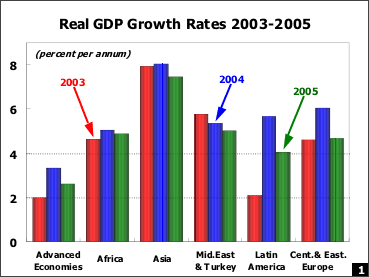
Healthy corporate balance sheets, accommodative macroeconomic policies and favorable financial market conditions are all helping to sustain the expansion. The terrible tsunamis that battered Indonesia and other Indian Ocean rim countries in December are not expected to have a substantial impact on regional growth. Despite their appalling toll in human lives lost and property destroyed, their macroeconomic impact in the larger countries will not be large.
Clearly, there are risks to the short-term outlook. In particular, the increasing divergences in regional growth rates in recent months is a disquieting aspect of the current expansion.
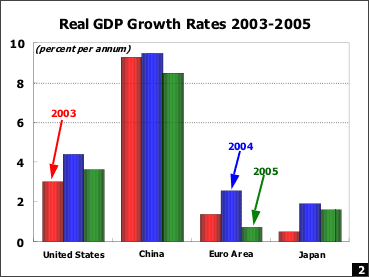
Forecasts have been revised upwards for the United States, China, and most other emerging market countries. In the euro area and Japan, however, growth projections for 2005 have been marked down significantly, reflecting both faltering exports and weak final domestic demand. In addition, oil prices have already surpassed the highs reached last October, and the oil market, which is already tight, can tighten further. Another source of uncertainty are the consequences of a potential increase in the price of risk as monetary authorities withdraw the liquidity that is sloshing around world financial markets.
Current Account Imbalances
The divergence in growth rates leads me to the topic for discussion today: Global current account imbalances. I refer here to the large U.S. current account deficit—and the counterpart surpluses which are concentrated in comparatively few countries in Asia.
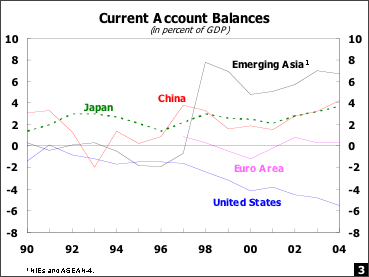
It may be helpful to review how we reached here. Starting from close to balance in the early 1990s, the U.S. current account deficit is now estimated to be about $645 billion in 2004, or the equivalent of 5½ percent of GDP. The increases that have taken place in the past year largely reflect the cyclical growth differential between the United States and its major trading partners, and to a far lesser extent, the rise in the price of oil.
The string of current account deficits has led to a substantial increase in U.S. indebtedness to non-residents.
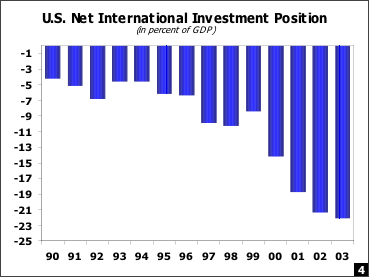
At end-2003, the net external indebtedness of the United States (i.e. net claims of non-residents) amounted to over 250 percent of exports of goods ands services, and about 25 percent of GDP.
Saving and investment balances compared
Because a country's current account deficit is the difference between what it invests and what it saves, it is instructive to analyze the relative importance of changes in investment and changes in savings in explaining where we are. The increase in the U.S. current account deficit that took place during the second half of the 1990s is attributable to an increase in U.S. private sector investment, and not to a fall in saving.
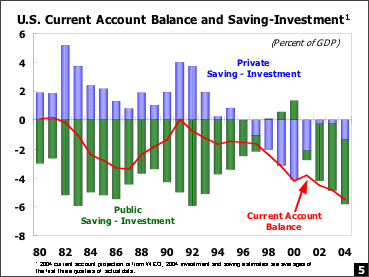
Since 2000, however, the increase in the current account deficit has reflected mostly a decline in public sector saving because of the growing fiscal deficit and a further decline in an already low household savings rate. Private investment, despite its welcome pickup since 2003, remains below its levels of the mid 1990s.
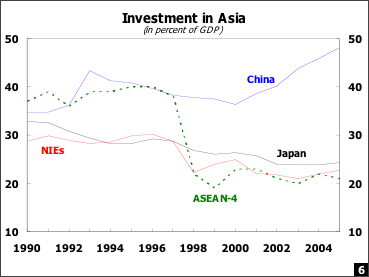
In the ASEAN countries and the NIEs, the increased current account surpluses result from a marked drop in investment, largely a reaction to the excessive investment prior to the 1997-98 crisis. In Japan also, investment has fallen steadily following the bubble years. By contrast, the savings rate did not change much in all these countries, so they started running large surpluses.
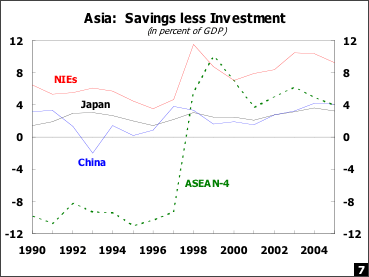
Finally, China is the exception in that investment has continued growing in the last few years, but it runs a large surplus because savings have grown even faster.
The savings-investment analysis suggests we need greater savings in the United States, stronger growth in Europe and Japan, higher investment in the ASEAN and NIEs, and greater consumption in China to narrow the imbalances. I will talk soon about policies that will be needed. But first, assuming that policies are in place to effect the adjustment, how will exchange rates have to move to help the adjustment.
Exchange Rates and how much further to go
It is important to note that the goal is not to have the United States run a current account surplus but to lower the deficit to a medium-term sustainable level. Our macro-balance calculations show that the United States with its higher productivity and younger population can sustain a deficit in the medium term of between 2 and 3 percent of GDP without it exploding. This means the United States needs to cut today's current account deficit (of about 5.5 percent of GDP) by somewhere between one half and two thirds.
On the face of it, this would require quite a bit of change in real exchange rates—at least according to a very persuasive paper by my predecessor, Ken Rogoff, and Maurice Obstfeld. Their argument is premised on the observation that U.S. spending on traded goods that can be sold abroad (such as a Hershey bar) is only about 30 percent of GDP. As a consequence, a reduction in the current account deficit of 3.5 percent of GDP requires that spending on traded goods decline by about 10 percent.
The rest of the spending goes on non-tradable goods like restaurant meals. Without a change in the relative price of tradable and non-tradable goods, the reduction in spending on tradable goods would be accompanied by a similar reduction in spending on non-tradable goods. Unlike Hershey bars, however, restaurant meals cannot be exported, so if spending falls, many waiters will be unemployed. To ensure that waiters are fully employed, the price of an entrée in terms of Hershey bars has to decline to prevent demand for them from declining as much as demand for Hershey bars. For this relative price change to occur, the dollar would need to depreciate substantially in nominal as well as real terms.
It is important to note the required depreciation of the dollar is not a given. If the current deficit must decline by, say, 3 percentage points of GDP within a year, the exchange rate adjustment necessary to achieve it will be much greater than if the period over which adjustment takes place is extended over three years. A longer period of adjustment will allow a greater pass-through of prior exchange rate depreciation into prices, as well as a greater response of production. In particular, over time, in the very flexible United States economy, waiters will become chocolate factory workers, so the supply of restaurant meals will fall to meet demand without a need for significant dollar depreciation.
At the same time, it would be problematic from the perspective of the financial sector if the adjustment took too long. The longer the period during which a large deficit is run, the more U.S. financial assets foreign investors will be required to purchase. To make the larger supply of dollar assets consistent with their desired portfolio demand for dollar assets, the U.S. dollar would have to depreciate more.
This implies that to minimize disruptive effects on the dollar, the adjustment of the current account imbalance should take place not too fast for the real sector and not too slowly for the financial sector. Is there evidence that the Goldilocks adjustment is taking place?
Effects of Exchange rate movements thus far
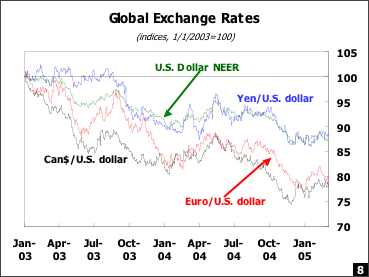
Since its peak in February 2002, the dollar has depreciated very markedly against the currencies of two of its major trading partners, Canada 25 percent) and the euro area (35 percent). In real effective terms, the decline of 17 percent is less marked but still large enough to have a discernible impact on trade volumes.
There is evidence that import prices have been affected by the exchange rate.
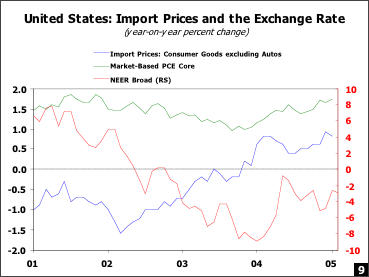
The behavior of both imports and exports suggests that the effect on actual volumes is still working itself through. However, given reasonably conservative elasticity assumptions, the depreciation to date would probably reduce the current account deficit over a period of several years by about 1-1¼ percent of GDP. But this is an other-things-equal calculation. What is not equal is the growth differential between the United States and its trading partners.
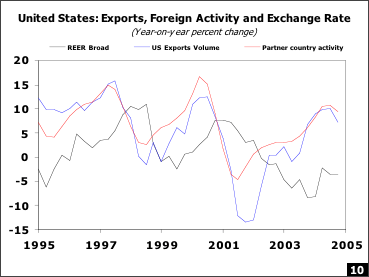
A strong predictor of U.S. export growth is indeed the growth of trading partners. Therefore, depreciation will help, but will have to be accompanied by a decline in the growth differential between the U.S. and its trading partners. I will offer some thoughts on policies to effect this shortly.
Can the Deficit be Financed?
If the real adjustment gets under way, will foreign investors continue to buy U.S. assets without hiccups for the time it takes for the real side to adjust?
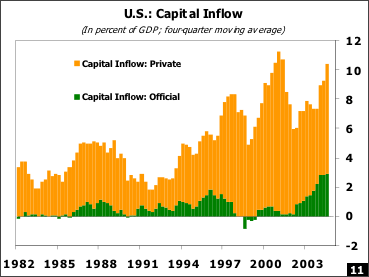
Let us look at the composition of capital flows into the United States for some clues to the answer. Overall, the bulk of U.S. assets sold to foreigners are still to the private sector. This may come as a surprise to some of you who believe that the U.S. current account deficit is being financed by foreign central banks. The reality is that while the foreign official sector has increased its purchases, it still only amounts to about one-third of the total gross inflows into the United States. So where is the rest going if foreign central banks are putting in enough to nearly match the deficit? The answer is that it is coming out again as U.S. investors buy foreign assets.
It is therefore entirely correct to say the U.S. current account deficit is more than fully financed by foreign private investors while U.S. private investment abroad is partly financed by foreign central bank investment in the U.S.. From the evidence we have so far, foreign central banks do not appear to vary their purchases of U.S. Treasuries in a systematic way with changes in the trade-weighted dollar. Profits are less important to central banks, and they are less likely to make a rapid shift in the composition of their reserve portfolio—though given their size, they have the ability to roil markets if they do, or if politicians hint they will. But before central banks turn decisively, foreign private investors who have no motive to buy dollars other than expected returns will have fled. It is they who are key to the financing of the U.S. current account deficit.
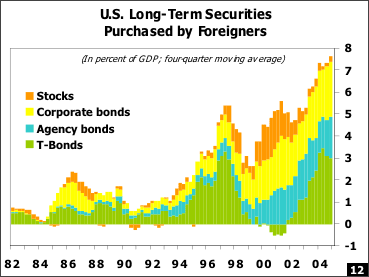
Given this, it is worth noting that both foreign direct investment and net purchases of equities by non-residents have declined markedly since 2000. Foreign direct investment has staged a partial recovery since then, but remains below 1 percent of GDP. The decline coincides with a drop off in M&A activity in the United States and overleveraged balance sheets in the Euro area and Japan. At the same time, net purchases of fixed income securities have increased substantially, with most of the increase consisting of Treasuries. On net, therefore, the form of financing has become less favorable, even though there have been no serious problems so far.
Given all this let me turn to how things will play out. Using a favorite metaphor of this region, will we have a soft landing, a hard landing, or no landing at all?
The Soft Landing
In my view, the soft landing is still the maximum likelihood eventuality though it will need supportive policy action. Consider the elements of the scenario. The United States could start saving more, partly by curbing its fiscal deficit and partly because private household savings start picking up.
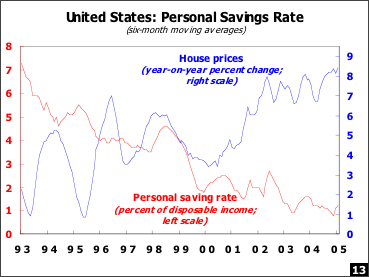
The spur to higher savings could be higher interest rates as monetary policy normalizes. An additional support to saving could be a slowing of house price growth. As the chart shows, there has been an inverse relationship between household savings and house price increases in the United States. While there is no question that fiscal consolidation in the United States is important, normalization of monetary conditions is also needed to narrow imbalances.
Asian domestic demand could expand, driven by a reforming financial sector that helps improve the quality, and increase the level, of investment. Expanding retail credit could enhance consumption, though the South Korean experience should warn against excessive exuberance. The high savings rate will fall as citizens become more confident of the security of their savings, and as explicit safety nets are created. Finally, greater exchange flexibility will result in moderately appreciated exchange rates over time, which will put greater purchasing power in the hands of firms and the people.
Structural reforms are likely to proceed slowly but surely in the Euro area and Japan. They will be especially helpful if they increase the efficiency of non-traded sectors such as retail, thus increasing domestic demand. And foreign private investors, understanding that there is a reasonable unwinding of the imbalances in sight, will be content to accumulate dollar assets. The steps I have just outlined, including fiscal consolidation in the United States, are all part of the general coordinated strategy that the Fund has been recommending to address the problem of global imbalances.
The hard landing
The alternative, of course, is that foreign private investors will doubt the resolve of policy makers. Recognizing that policies are not in place to close the current account deficit, they will realize that the dollar will have to depreciate significantly further. They will not wait to see that happen, instead they will sell dollar assets immediately. Paradoxically, this will force the adjustment: interest rates in the United States may spike up to attract back foreign investors and the exchange rate may depreciate more than necessary so that the anticipated appreciation will give investors an additional reason to return to the dollar. As I have argued, if adjustment is forced into the short run it will entail more depreciation, more dislocation, and slower growth than if the adjustment has time to play out. I do not think that this is the most likely scenario. But given its costs in terms of output and employment foregone, we must not dismiss it.
A Third Possibility: No Landing or What me worry?
There are, however, economists, notably Dooley, Garber, and Folkerts-Landau, who suggest the possibility that no landing is necessary—that the current global imbalances reflect a conscious and stable arrangement between surplus and deficit countries—one they term the New Bretton Woods (NBW) system. Their argument is gaining currency, so I will take a detour to address it.
Its essence is captured by Jacques Rueff, a French economist who is supposed to have said that if he had an arrangement with his tailor, under which the tailor returned the money that he (Rueff) paid for a suit the very same day, he would not be averse to ordering more suits. The Dooley et. al. thesis puts the United States in the position of Rueff and the surplus countries of emerging Asia in the position of the tailor.
More prosaically, the argument goes, China has over 200 million surplus workers who need to be absorbed into the workforce rapidly or they could foment social instability. Given the inefficiency of firms oriented towards domestic production, what better way to create jobs and new efficient firms than by exporting to the United States, aided initially by an undervalued exchange rate? Of course, this creates tensions in the United States where jobs are seen as being "lost" to China. China therefore enlists U.S. multinationals to fight its political battles by allowing them to invest in China and reap the profits from using cheap workers. Also, the U.S. Treasury bonds China accumulates as a counterpart of the trade surpluses it runs serve as collateral, posted to reassure U.S. investors that their foreign direct investment into China will be treated well.
This is a very clever argument, as should be expected from former members of the IMF Research Department. But I have fundamental disagreements with it.
First, is it an accurate description of what is really going on? For instance, does China really have a strategy of undervaluation? If so, why did China allow its currency to strengthen with the dollar a few years ago? Moreover, the political economy story sits inconveniently with the fact that the bulk of FDI flows to China come from Japan and the NIEs—from whom China is a net importer of goods—than from the United States. I could go on, but my first point is that the New Bretton Woods hypothesis imputes far too much design to what is more likely due to a series of coincidental events that only peripherally involve China—the collapse of savings in the United States and the collapse of investment in emerging Asia outside China.
Let me turn, however, to a second question: if indeed there were such a conscious strategy of undervaluation, would it be sustainable? Economic theory suggests that governments cannot control the level of the real exchange rate simply by fixing the nominal rate. As trade expands, the export sector will adopt new technologies and learn how to do things better. Because of these productivity improvements, real wages in the export sector and, hence, in the whole economy, must rise. This is development in action. The domestic-oriented (non-traded) goods sector does not enjoy the productivity gains of the export sector, so, for firms to break even, prices in this sector must rise. To be sure, the large reserve army of unemployed and underemployed will moderate the rise in wages and prices, but because some forms of labor (experienced and skilled) are in limited supply, rise they must. With a fixed nominal exchange rate, real appreciation will take place through inflation.
So much for the theory. Given the obvious increases in Chinese export productivity and the fixed nominal exchange rate, we should see mounting wage pressures, and there is some recent evidence of it. Why have we not seen more? Perhaps because a country can keep a lid for some time on these inflationary pressures. On the microeconomic side, this can be achieved through a variety of distortions, for example, by administrative controls on prices. However, these would make the domestic sector even more unprofitable. As it is, many firms in China, especially in the state sector, survive largely because the government has directed cheap, subsidized credit to them.
On the macroeconomic side, sterilization can limit the inflationary consequences of reserve accumulation, while financial repression (such as interest rate controls) and a closed capital account limit the direct fiscal costs. The inflation genie can indeed be bottled up. Eventually, however, it will get out as all these controls lose their effectiveness. Long term undervaluation is simply too difficult to manage.
Let me turn to a third question: even if it were possible to maintain a strategy of undervaluation, would it be wise for the Chinese?
Underlying the proposed mercantilist strategy of China selling cheaply to the developed world are the assumptions that foreign demand growth is more reliable than domestic demand growth, and that by producing for foreign demand, Chinese industry will become efficient. Yet we have seen that to carry out this strategy, the Chinese financial system needs to be repressed, with interest rates kept at low levels.
Since Chinese firms do not face up to a true cost of capital, they have both an excessive incentive to invest and excessive profits with which to do so. The domestic sector, far from becoming more efficient over time, will misallocate more and more resources. The cost will be borne by savers who receive miserable returns on their investment. Given the weak and fraying social safety net, this will increase their need to save, thus depressing consumption. The repressed financial system, which is needed to support the undervalued exchange rate, will thus distort domestic demand, leading to excessive investment and too little consumption.
In short, the New Bretton Woods system, if implemented, would turn China into a nation of worker bees, slaving for a golden efficient future that would never arrive. Or put another way, the new Bretton Woods System reminds me of those problems we got in engineering school—how long would it take to fill a tank with water through a two inch pipe from the top when there is a hole of three inches in diameter at the bottom? The two-inch pipe is the external sector on the steroids of an undervalued exchange rate, while the three-inch hole is the domestic sector relying on a repressed and inefficient financial system. No prizes for guessing the answer: Forever!
Would it not be better to repair the hole, the inefficient financial sector? In doing so, it will become harder and harder to maintain the distortions that are needed to keep the real exchange rate fixed. Resources will, however, be better allocated, leading to an increasingly efficient domestic sector. Confident savers will start consuming more. Chinese authorities will also regain monetary control, and some ability to get away from the stop-go pattern of the past.
Would the possible real exchange appreciation render China uncompetitive? I think not. It is a misreading of history and plays to protectionist stereotypes to claim that China is competitive because it has an undervalued exchange rate. China has other advantages than its low labor costs including superb infrastructure. In many cases, Chinese firms are only competing against each other, and exchange appreciation is likely to result in a direct transfer from Western consumers to Chinese workers, and even possibly some benefits such as reducing the cost of capital goods imports.
In sum then, the costs to China of maintaining the inflexible exchange rate system are mounting, and the benefits waning. The true imbalance in the Chinese economy is not the fabled 200 million excess rural workers but the moribund financial system. The Chinese authorities understand this. They have indicated they will move to greater exchange flexibility, and are committed to financial sector reform.
In Conclusion
That was a long aside, but the bottom line is that I think the no landing scenario is extremely improbable. That leaves just soft landing and hard landing. The way to increase the odds of the former is through credible commitments by all the major parties to the kind of policies I have spelt out earlier.
In this interconnected world, no country is an island. The world needs more multilateralism, but that need not necessarily imply some kind of global do-gooding. In order to resolve the global imbalances without too much disruption, it is enough that countries adopt enlightened self-interested policies. Those policies will mean painful reform in some cases, which will use up political capital. Over time, however, the steady implementation of such policies will benefit our membership both individually and collectively by reducing one potent source of risk in the global economy. I hope our members will rise to the challenge. Thank you.
1 Talk by Raghuram Rajan, Economic Counselor and Director of Research, International Monetary Fund at the Crédit Suisse First Boston Conference, Hong Kong, March 15, 2005. This paper should not be reported as representing the views of the IMF. The views expressed are those of the author and do not necessarily reflect the views of the IMF or IMF policy.
IMF EXTERNAL RELATIONS DEPARTMENT
| Public Affairs | Media Relations | |||
|---|---|---|---|---|
| E-mail: | publicaffairs@imf.org | E-mail: | media@imf.org | |
| Fax: | 202-623-6278 | Phone: | 202-623-7100 | |


